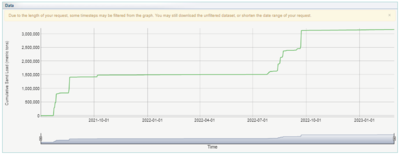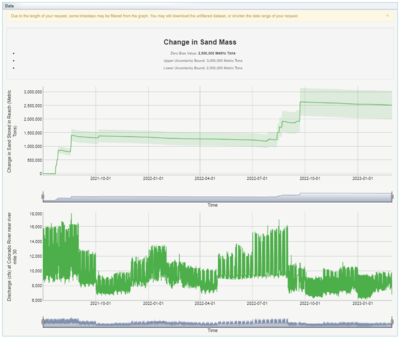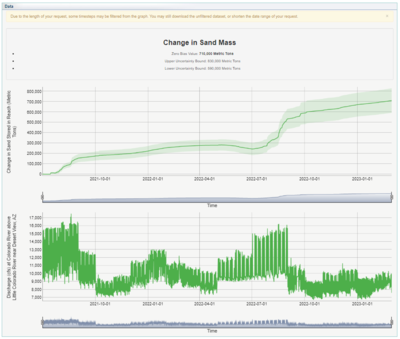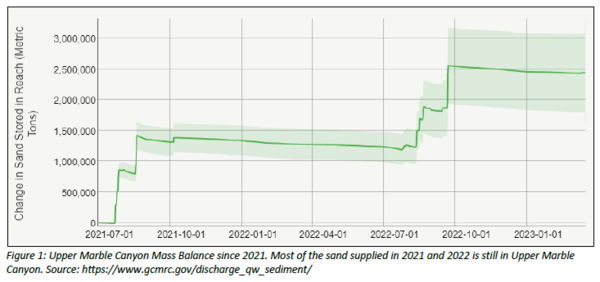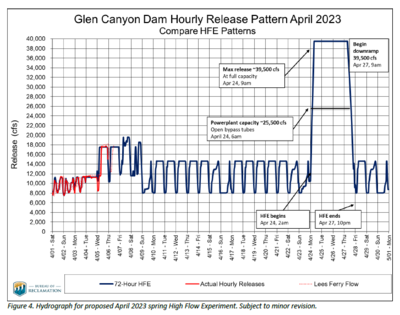The 2023 Spring HFE
| High Flow Experiment- 2023 | |
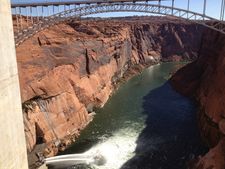 |
Contents
2023 Spring High Flow Experiment Snapshot
Sediment Conditions
Spring Accounting Period- Paria input (July 1, 2021 and March 1, 2023): +3,156,702 mt
- Accumulated in Upper Marble Canyon (July 1, 2021 and March 1, 2023, lower bound) = +1,991,672 mt
- Accumulated in Lower Marble Canyon (July 1, 2021 and March 1, 2023, lower bound) = +591,214 mt
- Available for Spring HFE: 1,991,672 + 591,214 mt = 2,582,886 mt
- Paria input (April 24 - 27): 380 mt
- Evacuated from Upper Marble Canyon (April 24 - 27, lower bound) = -751,108 mt
- Evacuated from Lower Marble Canyon (April 24 - 27, lower bound) = -132,436 mt
- Left over in Marble Canyon after HFE (April 24 - 27): 2,582,886 + 380 - 751,108 - 132,436 = 1,699,722 mt
Sediment conditions are currently ideal for supporting an HFE that will effectively rebuild sandbars because of a short window in late April where all eight generating units at Glen Canyon Dam are available to create a maximum magnitude of 39,500 cfs including full bypass. Fall 2021 and Fall 2022 were both major years for sand inputs from the Paria River. In both years, enough sand was supplied to support a full length HFE (i.e., 96 hours) but concerns due to drought and non-native species resulted in no HFEs being run in either year. Since July 1, 2022, ~1.7 million metric tons of sand have been supplied by the Paria, and between July 1 2021 and July 1 2022, ~1.5 million metric tons have been supplied. For context, the annual mean sand load (from 1997-2022) for the Paria is ~830 thousand metric tons, so both years are close to double the annual mean. Whereas HFEs have been shown to be effective in rebuilding sandbars (Hazel et al. 2022), the lack of HFEs since 2018 has resulted in continued bar degradation.
The HFE protocol in LTEMP defines two accounting periods for sediment, July 1 to November 30, and December 1 to June 30. A sediment-triggered HFE can occur when the Marble Canyon mass balance is predicted to remain positive at the end of the accounting period according to the Wright et al. (2010) Sand Routing Model. The mass balance in Marble Canyon reflects the sand inputs from the Paria River and sand export at River Mile (RM) 61; when sand inputs exceed export, the mass balance is positive.
Under LTEMP, the sediment accounting period resets on December 1, meaning that even when sand is in the system, it does not “count” towards triggering a subsequent HFE. However, there technically could be an abundance of sand in Marble Canyon that a high flow event would utilize for beach building. The rationale behind the LTEMP windows is to encourage HFEs as soon as possible following fall sand inputs, considering that winter dam operations could potentially export a substantial fraction of the sand supplied during the previous fall. In recent years, however, drought conditions have resulted in low winter dam releases, and consequently low sand export. As shown in Figure 1, large sand inputs to Upper Marble Canyon occurred in Fall 2021 and Fall 2022, followed by little export (most of the sand is still in Upper Marble Canyon).
Additionally, if not for the potential for high dam releases in April, May, and June, it is likely that enough sand could be supplied this spring to trigger an HFE under the existing spring accounting period. If we were to assume the typical 600 kaf releases for April, May, and June, the Sand Routing Model indicates that ~200,000 metric tons of sand are needed to trigger a 12-hour Spring HFE. The latest data from the GCMRC sediment website (https://www.gcmrc.gov/discharge_qw_sediment/) indicates that approximately 100,000 metric tons of sand have been supplied so far. The snowpack in the Paria watershed is unusually high, and when it melts we expect to exceed 200,000 metric tons of sand inputs. However, there is uncertainty in when the snow melt will arrive; it could occur gradually once the weather warms, or in a major flood if a rain-on-snow event were to occur. If a slow melt occurs, we predict a total of 200,000 to 400,000 metric tons of sand, but if a rain-on-snow event occurs, totals could quickly exceed 500,000 metric tons of sand. Given this uncertainty, it is unlikely that there will be sufficient lead-time to plan an HFE, even if one is ultimately triggered. This scenario changes substantially if high dam releases occur in April, May, and June. Assuming releases of 800 kaf in April, 1.1 maf in May, and 1.09 maf in June, the elevated releases would erode an extra ~880,000 metric tons according to the Sand Routing Model (Figure 2). This would preclude a sediment-triggered HFE under the Spring accounting period. For context, 880,000 metric tons of sand is roughly equivalent to the amount of sand exported by a 96-hour full-length HFE.
Examining the sediment mass balance window from December 1, 2022 back to July 1, 2022, which would better reflect the amount of cumulative sand load present in the system during the recent period of low monthly volume releases (i.e., sand that hasn’t yet been scoured), we find that there is adequate sand in Marble Canyon to support an HFE, even considering elevated spring monthly release volumes. Specifically, under a 1 -year accounting window, we obtain a sediment-triggered HFE duration of 72 hours (Figure 3). This estimate is still conservative, given that only sand inputs from Fall 2022 and beyond are considered, and not inputs from Fall 2021 nor spring 2023 deposits which have yet to arrive. We also used the standard conservative approach of considering the lower uncertainty-bound estimate of Paria supply for finding the sediment-triggered HFE duration.
In generating the above prediction, we used the latest available data for gage discharges and Paria inputs as of 3/27/2023. For the period beyond the availability of gage discharges at RM30 and RM61, we used the Colorado River Flow and Stage (CRFS) model to transform discharges from Lee’s Ferry to discharges at RM30 and RM61 (CRFS implements the Wiele et al. 1997 model). Projected hourly releases were not available at the time of this document, and so we used the observed hydrograph from 2022 and rescaled the discharges to match the projected monthly releases of 800 kaf, 1.1 maf, and 1.09 maf for April, May, and June, respectively. The 72-hour HFE was added on top of the April hydrograph, resulting in a total monthly release for April of 974 kaf. Although the details of the fluctuations are therefore likely to change, we do not expect this to substantially alter the results shown above or change our conclusions.
We additionally note that the Little Colorado River (LCR) has also supplied an unusually high amount of sand over the past year. Since July 1, 2022, the LCR has supplied roughly three times the annual mean, based on the period since 1998. The LCR is not formally considered as part of the HFE protocol, but given the exceptional sand load last Fall and this Spring, we expect any HFE to be highly effective downstream of the LCR due to sand-enriched conditions. In other words, sediment conditions are currently ideal for an HFE not only in Marble Canyon, but also in the Colorado River reaches downstream of the LCR.
In summary, there is a significant opportunity to take advantage of the last two years of significant Paria sand inputs to rebuild sandbars in the Colorado River downstream of Glen Canyon Dam with an HFE. As a result of high sediment inputs from both the Paria and the LCR, sediment conditions are currently ideal for rebuilding sandbars via an HFE. However, this opportunity is time-limited: if high dam releases occur as expected this spring into the summer, these will begin to export a significant fraction of the sand currently present in the system. By next Fall, much or all the sand supplied over the last two years could have been exported to lake Mead.
The opportunity to use some of this sand to rebuild sandbars will not persist indefinitely, which is similar in principle to the motivation for including the Proactive Spring HFE in the LTEMP. The intent of the Proactive Spring HFE in the LTEMP protocol was designed for the following, “…proactive spring flows [are] designed to "park' sediment before summer flows in high annual volume years.” In addition, the LTEMP ROD states that, ‘if it is determined that a sediment-triggered HFE cannot be implemented and the projected annual volume is greater than or equal to 10 maf, a proactive spring HFE will be triggered.” The following information suggests that current conditions are similar in principle to a high annual volume year that would trigger a Proactive Spring HFE. The latest runoff forecast suggests that 9.5 maf may need to be released in Water Year 2023, of which, 523 kaf that was intentionally withheld from release early in the water year to maintain Lake Powell water surface elevations must be released in the remaining months of the water year. Additionally, WY2023 started out with low monthly volumes because it was projected as a 7.0 maf release year, but now balancing releases of 9.0 to 9.5 maf year are projected. To ensure releases are achieved before the end of the water year, monthly volumes for the rest of the water year will be as high or higher than those during equalization years ≥10 maf. The necessity to move this water by the end of Water Year 2023 is also addressed in the Grand Canyon Protection Act (GCPA), Section 1802(b), providing that Glen Canyon Dam actions and operations must be fully compliant with the Law of the River. Therefore, the projected releases and unusual water conditions allow the consideration of an HFE to remain within the scope of the GCPA, as the projected water will need to be released with or without a potential HFE. (1)
HFE Details
Schedule & Duration
- Ramp-up from base releases at 4,000 cfs/hr at approximately 2:00 AM on Monday, April 24, 2023 (all times Mountain Standard Time and not hour ending) until reaching powerplant capacity (~25,500 cfs)
- Open first bypass tube at 6:00 AM on April 24
- Ramp-up from powerplant capacity to full bypass (~39,500 cfs) at one full bypass tube (~3,500 cfs) per hour in 4 hrs reaching total releases at 9:00 AM on April 24
- Stay at peak release (~39,500 cfs) for 72 hrs
- Ramp-down from peak release to base releases at beginning at 9:00 AM on April 27 using half bypass of 1,750 cfs/hr until reaching powerplant capacity and then decreasing at 2,500 cfs/hr
These recommendations result in the following release schedule at Glen Canyon Dam (also, Figure 4):
- Begin ramp-up from 10,500 cfs at 2:00 AM on April 24 (Monday)
- Reach powerplant capacity at approximately 6:00 AM on April 24
- Open bypass tubes at approximately 6:00 am on April 24
- Reach full bypass at 9:00 am on April 24
- Begin ramp-down from bypass at 9:00 AM on April 27 (Thursday)
- Complete HFE (back to 14,000 cfs) at 10:00 PM on April 27 (Thursday)
Ramp Rates
- Ramp up: 4,000 cfs/hr from 6,500 - 23,100 cfs, then 3,750 cfs/hr to peak (39,500 cfs)
- Ramp down: 1,875 cfs/hr from 38,100 – 23,100 cfs, then 2,500 cfs/hr to 9,000 cfs
- Maximum total release: 39,500 cfs
- Powerplant capacity: 25,500 cfs
- River outlet tubes: 15,000 cfs
- Hydropower generation units available: 8 (all units on-line for replacement)
- River outlet tubes: 4
Releases and Lake Elevation
- Releases will resume normal operations after the HFE
- Lake elevation is projected to decrease by approximately 1.5 feet during the 4-day experiment
- Estimated acre feet of water bypassed during HFE: 14 kaf
- The release volume required in April for the potential 72-hour HFE is approximately 279,000 acre-feet. This experiment is proposed to be conducted as a within-month occurrence in April 2023, thus no water will be borrowed from other months in WY2023.
Costs
- Estimated costs to hydropower: $1.4M
- Actual costs to hydropower: TBD
- Direct expenses for removal of concession assets: TBD
Recommendation Summary
Based on the LTEMP Record of Decision (ROD) and by way of a Supplemental Information Report, the Glen Canyon Dam Planning and Implementation (PI) Technical Team has worked over the past several weeks to evaluate existing information and data in determining this recommendation regarding a HFE at Glen Canyon Dam. At first the PI Team focused on considering a recommendation to implement a Spring HFE as the term is used and defined in LTEMP (i.e., a sediment-related experiment triggered by sediment input from the Paria River during a December to June accounting period) but the PI Team quickly concluded that there would not be enough sediment to trigger a Spring HFE. The PI Team then changed focus and began to consider a recommendation to implement an alternative HFE. This HFE is defined here as an “April HFE” to distinguish it from the term “Spring HFE” found in the LTEMP. The PI Technical Team’s recommendation regarding implementation of a spring 2023 high flow release is based on a careful assessment of resources and best available science. The PI Technical Team was unable to come to a consensus recommendation on an April HFE, partly because the legal rationale for authorizing implementation of an April HFE was undefined at the time, but Department of Interior agencies and the Arizona Game and Fish Department were all in support of an HFE and all other voting members were interested in forwarding the report along with a recommendation that the Leadership Team take up the spring high flow release concept below for consideration.
By a non-consensus vote, the PI Team recommends that the Leadership Team take up consideration of a 72-hr duration high flow release in April 2023. Six entities support the technical merits of a spring high flow release, five entities supported referral of the decision to the leadership team without a technical recommendation, and four entities abstained entirely from casting a recommendation.
Support for moving consideration of the April HFE to the Leadership Team by PI Team State participants was based on the following conditions:
- that Reclamation acknowledges this action does not create precedent for future or similar actions that might be proposed outside the analysis of environmental impacts considered in the LTEMP;
- that a Supplemental Information Report (SIR) will be prepared to document the review of new information to determine the sufficiency of the existing LTEMP analysis and subsequent decision;
- that the state participants have an opportunity to review the SIR before an April HFE is implemented;
- that this expedited review is outside of standard LTEMP practices and must not become a regular tool; and
- that this expedited process created additional uncertainty for Planning and Implementation members that is greater than during the usual consideration given when being asked for guidance regarding flow recommendations.
Planning/Implementation (PI) Leadership Team Recommendation
On April 10, 2023, the Glen Canyon Planning/Implementation (PI) Leadership Team finalized a majority recommendation to implement a Spring Flow Experiment (2023 Experiment) at Glen Canyon Dam in April 2023. Eight entities recommended the Spring Experiment, and 7 entities abstained from making a recommendation. No members objected to the 2023 Experiment based on information contained within the PI Technical Team Report and Recommendation.
The recommendation was developed and evaluated within the adaptive management framework and provisions of the 2016 Record of Decision (ROD) for the Glen Canyon Dam Long Term Experimental and Management Plan (LTEMP) Final Environmental Impact Statement (LTEMP ROD) concerning annual planning for flow-based experiments.
In accordance with the LTEMP, the Department may make the decision to conduct flow-based experiments (e.g., High Flow Experiments (HFE), Macroinvertebrate Production Flows, Trout Management Flows, and Low Summer Flows) at Glen Canyon Dam if it is determined that there are no unacceptable adverse impacts on other resource conditions. LTEMP states that “Prior to implementation of any experiment, the relative effects of the experiment on the following resource areas will be evaluated and considered: (1) water quality and water delivery, (2) humpback chub, (3) sediment, (4) riparian ecosystems, (5) historic properties and traditional cultural properties, (6) Tribal concerns, (7) hydropower production and WAPA’s assessment of the status of the Basin Fund, (8) the rainbow trout fishery, (9) recreation, and (10) other resources.” Water Year 2023 was the sixth full year of implementing the process for annual experimental planning under the LTEMP ROD. For future experimental planning, the Department welcomes input from each of the Leadership Team members as to whether the current process or another process should be used to satisfy the coordination and communication requirements under the LTEMP ROD.
Traditionally Associated Tribes are notified at least 30 days in advance of planned experimental flows. On February 22, 2023, notification of the possible 2023 Experiment and offer for consultation was emailed to the Tribes and Parties to the LTEMP National Historic Preservation Act Section 106 Programmatic Agreement (LTEMP PA). A follow up letter was sent on March 29, 2023. At this time, no requests for consultation regarding the potential 2023 Experiment have been received.
The LTEMP ROD specifies the representation requirements for planning experiments at Glen Canyon Dam and is based on past successful planning and implementation of flow-based experiments. The PI Technical Team includes technical representatives from the Bureau of Reclamation (Reclamation), the National Park Service (NPS), the U.S. Fish and Wildlife Service (FWS), the Bureau of Indian Affairs (BIA), the U.S. Geological Survey’s (USGS) Grand Canyon Monitoring and Research Center (GCMRC), Western Area Power Administration (WAPA), the Arizona Game and Fish Department (AZGFD), the seven Colorado River Basin States (States), and the Upper Colorado River Commission (UCRC). The PI Leadership Team is made up of decision makers from the same organizations.
The 2023 water year was an exceptional hydrological period for the Colorado River basin. High snowpack in the western United States was a welcomed change following multiple years of severe drought conditions. The low annual release volumes for the last year have also enabled the holdover of large amounts of sand in Marble Canyon, which in higher volume release years is quickly washed downstream. The 2023 Experiment takes advantage of that holdover sand and the new sand inputs from the Paria River from 2023 together with an anticipated large annual release volume of up to 9.5 million acre-feet in water year 2023. Focused analysis on the implications of this 2023 Experiment showed that there is no exacerbation of the non-native fish issues in the Colorado River below Glen Canyon Dam. In fact, no unacceptable adverse effects to any LTEMP resources were revealed within the Technical Report for any resources by the Planning and Implementation Technical Team.
Though the sediment triggers outlined by LTEMP ROD were not explicitly met during the accounting window to implement a spring HFE, the unique hydrology and sediment conditions in 2023 presented an exceptional opportunity to implement positive actions on the river, including compliance with the Grand Canyon Protection Act through a high flow action. Thus the 2023 Experiment was proposed and then analyzed under a Supplemental Information Report (SIR), which concluded that the 2023 Experiment is covered under the analysis of the LTEMP Final Environmental Impact Statement. This type of spring flow action has been promoted by many members of the GCDAMP for years and was planned and will be implemented in a similar manner as a LTEMP spring HFE. The analysis in the SIR was undertaken for this 2023 April Experiment and the unique current conditions. The analysis, including the expedited consideration by the LTEMP PI Team, does not set a precedent for future LTEMP implementation.
Within the LTEMP, fall HFEs were predicted to be conducted frequently (~3 out of every 4 years) and it has been four years since the most recent HFE was triggered and implemented (fall 2018), and no spring HFEs have yet to be triggered. LTEMP anticipated spring HFEs in "26%" of the years covered under the 20-year period (i.e., 5 out of 20 years). The LTEMP anticipated proactive HFEs would occur in 10% of the years, so 2 out of 20. The GCDAMP is generally behind schedule for HFEs according to the above information, and sandbar condition in the Grand Canyon is currently poor owing to lack of HFEs and high monsoonal activity that has created gullies that make many sandbars inhospitable to camping.
This 2023 Experiment will provide a renewal of Grand Canyon beaches, which are used by over 25,000 visitors per year and have not been rebuilt since the last HFE in 2018. The 2023 Experiment creates progress towards a variety of LTEMP resource goals, including but not limited to the Sediment, Recreational Experience, Natural Processes goals.
Though there was majority support for the 2023 Experiment, support from Arizona and California was contingent upon the following qualifications:
Arizona (Department of Water Resources) and California support the 2023 Experiment recognizing the following:
- There are unprecedented and unique water supply and dam operation opportunities on the Colorado River in Water Year 2023, such as delayed balancing releases and the need to release additional water withheld in Lake Powell under modified DROA operations;
- The total actual sand accumulation load upon implementation is ~2.5 million metric tons, and Upper Marble Canyon is projected to receive an additional ~200,000 to ~500,000 metric tons of cumulative sand load for an April 2023 Experiment by the end of the 2023 spring accounting window;
- Reclamation is projecting a total annual release between 9.0 to 9.5 maf from Glen Canyon Dam within the remainder of the 2023 Water Year;
- The experiment is expected to have positive impacts on LTEMP downstream resources in the Grand Canyon;
And conditioned upon the following:
- The experiment does not create precedent for future actions. Future actions will be limited to the express terms of the LTEMP ROD;
- The expedited Planning & Implementation process and stakeholder review will be limited to this experiment and will not become a regular consultation tool;
- That monthly volumes for the remainder of the 2023 Water Year under a 9.0 to 9.5 maf release will not be significantly redistributed from the currently projected release patterns;
- This experiment will not result in lower Lake Powell reservoir elevations below the current projected May 1st elevation on May 1st of 2023;
- Pre- and post-experiment monitoring must occur to fully document and facilitate analysis of the effects of the experiment; and
- This support applies to Water Year 2023, and only to the extent that the experiment is within the scope and authority of the LTEMP ROD.
Based on the identification of high resource benefits by both the PI Technical and Leadership Teams, the determination of no unacceptable adverse impacts, and majority recommendation for the Department to implement a 72-hr duration Spring 2023 Experiment, I concur with the determination, and I have decided to conduct a Spring Experiment for 72-hrs of peak duration beginning on April 24. We will continue to work with our partners on future experimental flows and in the protection of the Grand Canyon and our most important resources. (2)
SUPPORTING DOCUMENTS
- Spring 2023 HFE - Decision Memo: Notification of Decision to Implement a Spring Flow Experiment at Glen Canyon Dam
- Final Technical Report and Recommendation Regarding a Spring Flow Experiment at Glen Canyon Dam, April 2023
- Reevaluation of the 2016 Long-term Experimental and Management Plan Final Environmental Impact Statement (LTEMP FEIS) and Record of Decision (ROD) for the 2023 Spring Flow Experiment (2023 April Experiment)
COMPLIANCE
The Adaptive Management Group of the Region’s Upper Colorado Operations Office has prepared the attached Supplemental Information Report (SIR) for the 2016 LTEMP FEIS and ROD. A SIR is an informal document that federal agencies use to review whether the agency’s National Environmental Policy Act (NEPA) documentation remains adequate for a particular proposed action. This SIR describes the unique conditions surrounding the 2023 April Experiment and its relationship to other LTEMP experiments to assess whether the 2023 April Experiment would constitute “substantial changes to the proposed action [LTEMP implementation] that are relevant to environmental concerns” or “significant new circumstances or information relevant to environmental concerns and bearing on the proposed action or its impacts.” 40 C.F.R. § 1502.9(d)(1).
The proposed 2023 April Experiment consists of a 72-hour on-peak duration high flow experiment utilizing a 39,500 cfs magnitude which is enabled by full availability of eight generating units at Glen Canyon Dam and full bypass. Reclamation is considering the 2023 April Experiment because of the unique opportunity to benefit the sediment resource prior to high volumes being released from Glen Canyon Dam for the reminder of WY 2023. These elevated releases will degrade the sediment resource from its present condition. The 2023 April Experiment is designed to protect sediment currently downstream of Glen Canyon Dam that has remained largely in place due to lower annual flows in recent years. The SIR includes a review of affected resources in the LTEMP FEIS and ROD to determine if there is new information and its potential to disclose significant new circumstances or information relevant to environmental concerns or impacts of the 2023 April Experiment. Overall, Reclamation has concluded that there are no significant new circumstances or information relevant to environmental concerns, and the 2023 April Experiment does not cause any new or unforeseen impacts since completion of the LTEMP FEIS and ROD.
The analysis in this SIR is provided only for this 2023 April Experiment and the unique current conditions. The analysis, including the expedited consideration by the LTEMP Planning and Implementation Team, does not set a precedent for future LTEMP implementation.
Based upon our review and analysis of this information, it is our conclusion an EIS supplement is not required for the proposed 72-hr 39,500 cfs Spring HFE in April 2023.
CONCERNS
Humpback chub
Thus, no direct unacceptable negative response would be expected to humpback chub from a spring HFE this year, based on current monitoring results and previous HFEs.
Hydropower and Energy
The HFE will require a modification of operations at Glen Canyon Dam that may include changes in release timing, which may require energy to be sold to the open market at reduced energy prices. In addition, bypass flows will result in a reduction of total energy produced. WAPA estimates the financial impact of implementing a 2023 Spring HFE at $1.4 million. For comparison with past HFEs, WAPA determined the financial impact at $1.1 million for 2012, $2.6 million for 2013, $2.1 million for 2014, $1.2 million for 2016, and $1.3 million for 2018. Total loss in energy production due to bypass flows and losses in efficiency are estimated to be -29,741 MWh.
Other Native Fishes
No direct unacceptable negative response would be expected among native fishes to a spring HFE this year, based on current monitoring results and previous HFEs. However, indirect effects from potential expansion of smallmouth bass create a risk to native fish.
Recreational Experience
The HFE should benefit recreational users through improvements to campable area and vegetation reduction in the near shore habitat.
Sediment
The potential spring HFE does not pose risks to the sediment conditions that were not previously analyzed in the LTEMP and will benefit most sediment resources.
Tribal Resources
The potential experiment would not be expected to cause unacceptable adverse impacts to tribal resources.
Rainbow Trout (Oncorhynchus mykiss) Fishery
A spring 2023 HFE would not be expected to have negative impacts on the rainbow trout fishery aside from the temporary and direct effect of the HFE on angling access that are described in the recreation section.
Nonnative Invasive Species
- Green sunfish have become more common and widely distributed in the Grand Canyon and high flows from May-Sept may also contribute to dispersal, so the risk to humpback chub is similar with or without a Spring HFE.
- No unacceptable exacerbation of risk to brown trout is expected and no unacceptable risks are anticipated.
- A spring 2023 HFE does not pose unacceptable risk to exacerbating the spawning, migration, and/or establishment of smallmouth bass below Glen Canyon Dam.
- A 2023 spring HFE does not pose unacceptable risks to endangered and/or native fishes.
Riparian Vegetation
A spring HFE is unlikely to significantly impact riparian vegetation resources over the long term and no unacceptable risks are anticipated.
Water Delivery - Monthly, Daily, and Hourly Releases
A spring 2023 HFE does not pose unacceptable risk to Lake Powell elevations. Remaining WY2023 hydrology confidence is high and accommodating of a Spring HFE.
ADDITIONAL
